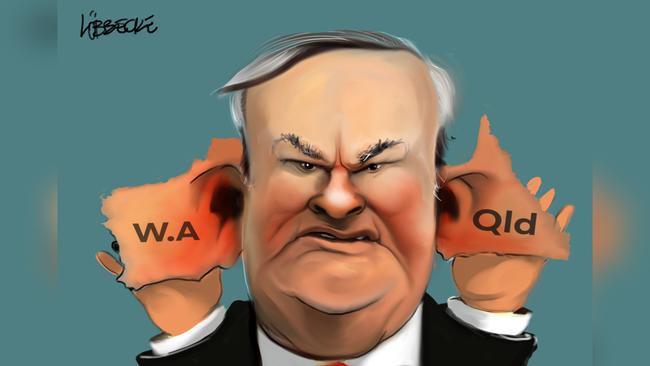The states Albanese needs to turn around for victory
Unless it heeds regional concerns, federal Labor will keep losing elections.

In many ways this is a reversal of what many people expected. The assumption was that, come polling day, enough voters had doubts about Shorten’s agenda such that undecided voters stuck with the devil they knew.
More and more Australians are deciding on election day who to vote for. While that phenomenon would have been in play to some extent, the greater factor that saw the election result differ from two years of consistent opinion polling was the propensity of voters unsure about Labor choosing to vote early to register their disapproval.
But all this isn’t the most important breakdown of voting patterns from the May 18 election results. It is the state-by-state breakdown from which Labor must learn if it wants to be competitive at the next election; namely, what happened in Queensland and Western Australia.
The opposition won only five of 16 seats in WA and six of 30 seats in Queensland. Labor won 57 seats around the rest of the country compared with the Coalition’s 43.
In other words, Shorten losing the unlosable election was a verdict delivered by specific parts of the country. Some sections of the ideological left have used this data to condemn these twin states and to claim some sort of moral victory for Labor across most of the nation, but such thinking is counter-productive.
We are a federation. Governments need to appeal broadly, which means understanding all parts of the country, not only those from which politicians hail.
While I can understand anger out of the US in 2016 when Donald Trump won the electoral college vote but three million more Americans cast a ballot for the Democrats, that didn’t happen here.
It wasn’t merely the electoral system that delivered the Coalition a remarkable victory. The Coalition won more seats and more of the primary and two-party vote than Labor did. While the margin was still tight (77 seats to 68), there is absolutely no disputing the mandate.
The twin frontier states of Queensland and WA rebuked the Labor agenda to such an extent that Labor winning well elsewhere simply didn’t matter. And these states have done so too often in recent federal elections for the federal arm of the Labor Party not to take note.
Something has to change.
Ironically, Queensland and WA are run by Labor governments. The relatively new McGowan Labor government in WA won a handsome victory at the 2017 state election and continues to travel well ahead of the next election.
While the long-term Palaszczuk Labor government has its problems, Labor has been dominant at the state level in Queensland for decades now.
So why does Labor do so badly in Queensland and WA at the federal level but not at the state level?
It is partly because the state Labor divisions are better at judging the mood of their constituents. Equally, the problem becomes a self-fulfilling prophecy. When representation from Queensland and WA declines in the federal Labor caucus, the issues that matter in those states don’t get the hearing they should.
Labor’s rigid factional system, which demands a somewhat proportionate carve-up of frontbench roles, also can dilute the influence of these states where it counts.
Which is why the role of the leader in combating the historical failure of Labor to tap into the sentiments of West Australians and Queenslanders is so important. Not mere photo opportunities and listening tours — which cynical voters are sick of — but in a policy sense.
It is no coincidence that WA and Queensland are resource-rich states. They are also far less politically correct than their eastern and southern state equivalents. Yet Labor (dare I say it, a little like the ABC) tends to focus its attention on the more urbane parts of the country.
What Anthony Albanese does as Labor leader will be interesting to watch. On the one hand he is a creature of inner-city Sydney, geographically and in terms of his progressive values. But he is also a genuine down-to-earth politician, who in time may contrast effectively with the Prime Minister, who portrays himself that way but may not be all that he appears.
Queensland is often misunderstood by people who don’t live or spend much time there, because its demographics are so unique. The non-capital city population of Queensland, especially up north, is much larger than in other states. As a result, the vote shifting issues these voters are interested in can vary considerably from what capital city voters think — even those living in outer metropolitan marginal seats.
While WA doesn’t have the same distribution of voters statewide that Queensland does, the sense of isolation people living in WA feel contributes to a “them v us” sentiment.
At the federal level the Coalition has tapped into this attitude more effectively than Labor.
In recent history the only two times federal Labor has been able to garner more votes in WA and Queensland is when a local has become leader. Kim Beazley managed to lift Labor’s share to level pegging in the west. Kevin Rudd managed to outpoll John Howard in Queensland.
This, no doubt, will be opposition Treasury spokesman Jim Chalmers’s pitch to colleagues if Albanese doesn’t win the next election. But merely making a local the leader is no cure-all in and of itself. Because Rudd’s policies ultimately weren’t well calibrated for Queenslanders — think the mining tax — they quickly turned on him.
Another challenge for Labor in trying to win Queensland is the merger of the Liberal and National parties. The LNP is a Frankenstein’s monster-like beast, to be sure. But it allows the conservative side of politics to pivot between who it portrays as the leader regional Queenslanders (remember there are a lot of them) should vote for. When the Nationals are popular, it highlights the Nationals leader — for example, the way Barnaby Joyce was used in the 2016 campaign, when Malcolm Turnbull was kept away from key Queensland seats.
However, the conservative side can pivot, as the LNP did this year, to the Liberal leader if it believes he is more popular in the regions of Queensland. The Nationals’ Michael McCormack didn’t play well in regional Queensland but Morrison did, so the Prime Minister was front and centre.
Peter van Onselen is a professor of politics at the University of Western Australia and Griffith University.




The Australian Electoral Commission has released data that shows Bill Shorten’s Labor Party won more of the two-party vote on election day than the Coalition did. However, Labor was trounced in the pre-poll and postal votes, which delivered Scott Morrison an unexpected victory.